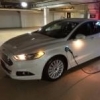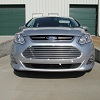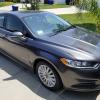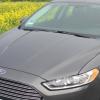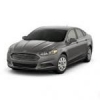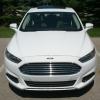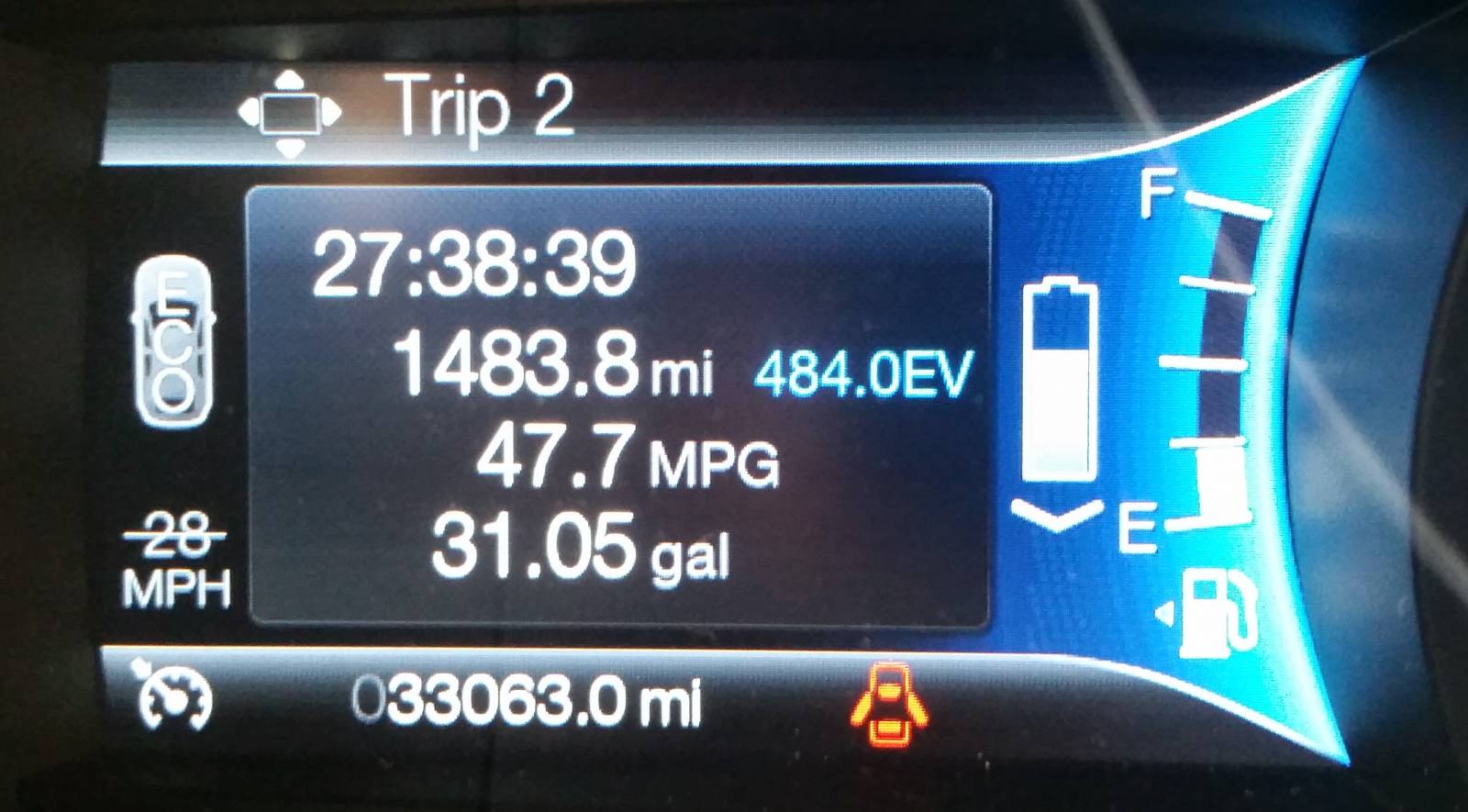Search the Community
Showing results for tags 'MPG'.
Found 60 results
-
Since I've got my '10 Fusion Hybrid back from the dealer (after the Takata airbag recall repair), I've noticed that it's impossible to run in EV mode unless I'm coasting to a stop or going downhill. Previously I could gradually accelerate to about 45 MPH using a very light foot and stay in EV mode the entire time, even cruising for a mile or so at that speed. My fuel economy is only down about 10%, 37 MPG vs. 40 MPG but it's frustrating to have the ICE kick in when it's unnecessary. Anyone else experience something similar?
-
On the C-Max Forum they have threads to post tanks of 600+ miles and 700+ miles so I'm stealing their idea for here. Let's see how we do. There are a ton of 600+ mile tanks over there and even quite a few 700+ mile tanks. Here are my last two tanks, both were 600+ mile tanks I just noticed that this pic shows the tank as partially full since I put the key in and took the pic while the tank was filling
-
After driving our 2013 Ford Fusion Hybrid to CA and back from MN I have a theory about how Ford achieved 47 MPG in testing when many of our results seem to belie that claim. This theory also explains why Ford is offering to work with the EPA to establish new testing standards for hybrid vehicles. First off let me say that I have no affiliation with Ford or the automotive industry. I'm also not a journalist, I'm a Business Analyst and a math nerd. Because I have a form of autism called Aspergers I pay lots of attention to numbers and data and pick up on patterns in data subconsciously. My thoughts here are only a theory of how Ford could possibly have achieved 47 MPG in their EPA testing when many car owners are not reaching that number. Please let me know if you have any other theories or ideas. First off, we need to understand how the EPA testing procedures work and the rules governing those tests. There are a number of different testing cycles used by the EPA. These cycles are designed to simulate “typical” driving patterns. Details of the cycles, including graphs, can be found at http://www.epa.gov/nvfel/methods/quickdds.htm. An explanation of the distinct cycles can also be found at http://www.cleanmpg.com/forums/showthread.php?t=1510. What are the limitations of the EPA cycles? Let’s first examine the city cycle. The city cycle involves a lot of acceleration and braking. However, there is not much time spent idling as if at a red light. During this test the Fusion Hybrid could spend a lot of time in EV mode, possibly even often accelerating in EV mode depending on the SOC (state of charge) of the battery. The EPA test procedures call for very slow acceleration, unrealistically slow in fact. The maximum acceleration rate in the EPA testing is 3.3 MPH/second. At that rate it would take about 18 seconds for 0-60 MPH. That is not the constant acceleration rate, that is the maximum acceleration rate. At other parts of the testing the acceleration is even more languid. The highway cycle also has its flaws. The highway cycle calls for a maximum acceleration rate of 3.2 MPH/second, even slower than in the city cycle. The highway test also does not measure fuel economy at a constant cruising speed. The graph looks more like what your speed would look like if you were doing pulse & glide for maximum fuel economy. The average speed is 48 MPH and the maximum speed is 60 MPH. This cycle includes no stops, no idling and begins with the engine already warm. All those factors will contribute to higher highway fuel economy. To help offset these disadvantages the EPA created the high speed cycle in 2008. The high speed cycle includes faster acceleration and a top speed of 80 MPH. However, the average speed in the high speed cycle is only 48 MPH. If you look at the graph you can see that it includes multiple stops and time spent idling. The high speeds are sustained only for a very short period of time. This test also starts with a warm engine. Then there’s the AC cycle with warmer temperatures. This cycle is designed to lower the overall fuel economy numbers to be more realistic with summer driving using the AC. The cold temperature cycle is a repeat of the city cycle except with the lab temperature lowered to 20 degrees. This test also includes a cold engine at the start. What are the overall limitations with the EPA tests? The highway speeds are too low for starters. We now have roads with speed limits as high as 85 MPH and many highways, even in the city, are increasing their speed limits up to 65 MPH. The EPA highway cycle looks more like typical driving on suburban county roads for someone who lives out in the outer-ring suburbs. The tests also underestimate the amount of time spent idling in city driving. Most city commutes are going to have a lot more time spent idling than the tests show. The tests do not include the use of AC or heat. In many parts of the country AC is a necessity for most of the year, and heat for the remaining months. The tests also don’t account for winter driving conditions. Lowering the temperature in the lab to 20 degrees is not the same as driving in winter. There is more resistance in the winter due to snow, sand and salt on the roads. But, the biggest flaw though is the cycle length. In an 11 mile city drive the fuel economy will be markedly better than in a 5 mile city drive. An 11 mile city drive is much too long. Most of our trips in the city are less than 2 miles, with the occasional trip being between 5 & 10, but very rarely do we do a city drive more than 10 miles. This greatly affects fuel economy in the Fusion Hybrid because of waiting for the engine to warm up. The EPA does not state that the heat should be turned on for the cold temperature cycle. In a hybrid this is very important, as turning the heat on will keep the engine running thus lowering MPG results. Driving with the heat off in cold weather will raise the MPG numbers, but is not realistic. The EPA test cycles factor in the aerodynamics of the vehicle but not wind. Wind is a big factor in highway fuel economy. In some non-scientific tests that I have done with our Fusion Hybrid I have found that a 10 MPH crosswind can lower fuel economy by 2 MPG or more. So, now that we understand the limitations of the EPA cycles we can focus on Ford. I fully believe that Ford also identified these limitations and built the Fusion & C-Max to take advantage of the unreal reality that is the EPA tests. For example, why program the Fusion and C-Max to do a maximum of 62 MPH in EV mode? Where does that number come from? Why 62 MPH and not 60? Or 65? Or 55? The answer can be found in looking at the EPA test cycle graphs. The city cycle includes a maximum speed of 56 MPH, in the highway cycle the max speed is 60 MPH, 54.8 MPH in the AC cycle and 56 MPH again in the cold temperature cycle. This means that in all those tests the Ford hybrids can potentially run in EV mode the entire cycle. And while we know that the car could not go the entire distance under battery power, we do know that as soon as the cycle calls for deceleration the Ford hybrids can switch over to EV mode for gas free coasting. Ah, but what about the high-speed cycle you say. Take a look at that graph too. Even though it calls for a maximum speed of 80 MPH, the time spent above 62 MPH is minimal. The test calls for cruising around 62 MPH and then acceleration up to 80 MPH for less than 60 seconds. Once that one minute burst of speed is over the cycle calls for speeds that are mostly below 62 MPH. I believe that Ford specifically identified the 62 MPH EV mode limit as the best way to maximize their results on the EPA cycles, not necessarily as the best way to maximize fuel economy for their customers. In what other ways could Ford have manipulated the results? What about the battery SOC at the start of each cycle. The EPA doesn’t have strict guidelines for hybrids like there are for gasoline cars. While the EPA does specify for each cycle whether it starts with a cold engine or a warm engine, nothing specifies the hybrid battery SOC. From more unscientific testing that I have done, starting with a near 100% SOC is worth easily 5 MPG over starting with the SOC under 25% in short or medium length trips, like the EPA test cycles. This effect is magnified in highway driving because at higher speeds the engine spends a larger percentage of the distance running than in city driving. By watching the instant fuel economy gauge on the dash it is possible to see this effect while cruising on the highway. For example, cruising on flat ground at 60 MPH the instant fuel economy will show somewhere between 35-45 MPG depending on the ambient temperature if the battery is nearly full. When the battery SOC is low, the same conditions yield an instant fuel economy of 20-30 MPG. That’s a big difference, 15 MPG. So if Ford starts the highway cycle with the battery SOC near 100%, then the car will be able to spend more time cruising in EV mode and less time returning 20-30 MPG while recharging the battery. My second theory is thus that Ford started the different test cycles with a battery with a SOC well higher than 50%. And, since the EPA has not established guidelines regarding the SOC of hybrid batteries for the test cycles Ford did not break any rules in doing this. Thus, Ford now offers to work with the EPA to develop new testing procedures for hybrids that would account for such measures. That offer is a smart move on Ford’s part because they can then say that they are working to satisfy consumers by “building a better mousetrap” as it were. What can we do about it? In short, nothing. I don’t think the lawsuits will succeed, and unless the EPA finds that Ford broke some rule we aren’t going to see a refund like Kia & Hyundai were forced to hand out. There is a reason why the EPA mileage estimates come with the disclaimer: “Your mileage will vary”. This disclaimer is there because the tests have their flaws and limitations. What do we do then? Rather than complaining and trying to sue Ford, people need to grow up and learn to deal with it. Before we bought our Fusion Hybrid we test drove the Fusion & the Camry Hybrid. The Camry is rated much lower by the EPA for fuel economy (40/38/40). I wanted to see for myself. So my wife and I drove a specific route that simulated our normal driving. Our testing revealed 46 MPG overall in the Fusion and 45 MPG overall in the Camry doing the same driving route. “Your mileage will vary.” Does this mean that Toyota understated the fuel economy of the 2012 Camry Hybrid? No, it simply means that “your mileage will vary”. The EPA fuel economy numbers are estimates. What is an estimate? It is a rough calculation or an approximation of a value. The EPA estimates that you will get 47 MPG. That means that if you drove the EPA test cycle 100 times you should come out with 47 MPG as the average. Some times you might get 50 MPG, other times 45 MPG, etc. This does not mean that you will get exactly 47 MPG driving to work, to the store, to the mall, etc. This means that if you follow the very specific guidelines the EPA sets forth, and drive in a lab, with no AC, with no wind, with no cargo weight in the car you will get 47 MPG. However, if you are not driving in a lab, with no AC, with no wind, with no cargo weight in the car and are driving to work, school or the mall, then “your mileage will vary”. Really what is needed to find the solution to this conflict is not a lawsuit against Ford. Ford never states “you will get 47 MPG”, they merely hype the fact that the EPA test cycles return 47 MPG. And, what’s wrong with them doing that? It’s their right to advertise the EPA estimates of their cars. And it’s our responsibility as consumers to make wise decisions based, not on advertising alone, but on other factors. So what if the EPA mileage is 47 MPG and you’re only getting 38 MPG? Have you considered all the factors that make your driving different from the EPA test cycles? Do you ever drive on windy days? Are you driving in warm weather with the AC turned on? Are you accelerating faster than 3.3 MPH/second? Are you driving faster than 60 MPH? If the answer to any of those questions is “yes” then you have your answer as to why you aren’t getting 47 MPG. Since none of us drive the EPA test cycle on a daily basis, is it any wonder then that we don’t see 47 MPG? Maybe what’s needed here is a change in perception, a change in how we think about the EPA estimates; not of a lawsuit and a bunch of whining.
- 47 replies
-
- MPG
- gasmileage
-
(and 1 more)
Tagged with:
-
If you look careful, the engine tach indicates ~1.2k rpm, the mpg readout at roughly 55mpg. I've seen this stuff on Geo metros, or Mitsubishi Mirages, doing 35-50mph, but never on any vehicle doing 75mph. It also kept that mpg rating for most of the ride. Just required extreme throttle precision, and a foot that won't move the throttle by even a single millimeter! https://youtu.be/axH4_pB8fDE
- 11 replies
-
Posted 25 October 2015 - 09:56 AM Now that temperatures are going down for Newbies you may have noticed your MPG's go down also. You can expect 2 MPG drop for each 10*F drop in temperature. So a temp drop from 70*F to 40*F would be a drop of 6 mpg. Here is what you can do to to get some of that back without spending a lot of money. 1. Use some kind of Grill blocking method, Grill Covers, foam insulation or tape. Center Grill opening should be covered all year around, I have been using Grill Covers for 4 1/2 years/ 150K mi. now. I only remove the lower Grill Cover when going on long uphill grades. Worth 2-4 mpg's Grill Cover using Clear Packing Tape Grill Cover using Velcro attachments LEXAN Plastic 2. Use 50 PSI in your tires, not much difference in ride quality, but it improves mpg's and your tires wear great. I got 64k mi. on first and second set. Worth up to 1mpg. 3. Oil Pan Heater speeds up ICE heating and heat available for the car heater. The only Oil Pan Heater I could find small enough to fit the bottom of oil pan was a Wolverine Model 9 Oil Pan Heater which you can get on eBay. You can put one on the back of the block to have a total of 250 Watts, but enough to raise WT by 40-50*F. Worth about 2-5 mpg on short trips and you have heat almost immediately. YA! BTW I put a block heater in mine which adds about 400watts and 65*F increase in temp which is great, but it is very hard to install. 4. Park facing the Sun which will keep ICE and inside of car warmer. If you can use seat warmers instead of heater. Worth 1-4 mpg. Make trips during the warmest time of the day. These are kind of obvious ideas, but they are worth mentioning. 5. Premium Gas is worth 2 mpg in my experience, but may not be worth the additional cost. That is what I use. Note: 1. The first time you start the car, cold or hot, HVB charged or not, ICE will start running when you hit 35mph to lubricate Transmission. 2. ICE wants to get to 128*F before it will operate normally. With ICE block heater and oil pan heater I have been able to get to this temperature and be in normal mode almost from the start. I think it is more efficient to use the EV to get to speed so when ICE comes on it is making significant power to move car, charge HVB and heat up up the ICE quickly. 3. When temps drop below 70*F it's time to block the top grill to keep the ICE compartment warmer. This can be done as simple as using clear packing tape from hood down to bottom of top grill or use LEXAN sheet cut to fit the opening. 4. When accelerating use two BARs on the Empower Gauge, this is where the ICE is most efficient, heats up ICE quicker and charges HVB faster. 5. Use EV from a start to 15-20mph, this gives good acceleration and is more efficient than ICE at those slow speeds. Remember you want to minimize ICE time and maximize EV time to get good gas mileage. Paul
-
OFFLINE ptjones I have about reached the limit for AERO and Temperature Efficiency Improvements like Grill Covers and Wheel Covers for my CMAX. With temps in the 80's*F I can average 50-54mpg at 65-70mph with no A/C on the HWY. Not bad, but I'm still looking to improve more. I remembered someone had said the ICE is very inefficient so I looked it up and to my surprise it is only 25-30% at best. WOW So looking at GOV site and Wikipedia http://www.fuelecono...v/feg/atv.shtml https://en.wikipedia...gine_efficiency From Wikipedia: "Modern gasoline engines have a maximum thermal efficiency of about 25% to 30% when used to power a car. In other words, even when the engine is operating at its point of maximum thermal efficiency, of the total heat energy released by the gasoline consumed, about 70-75% is rejected as heat without being turned into useful work, i.e. turning the crankshaft.[1] Approximately half of this rejected heat is carried away by the exhaust gases, and half passes through the cylinder walls or cylinder head into the engine cooling system, and is passed to the atmosphere via the cooling system radiator.[2] Some of the work generated is also lost as friction, noise, air turbulence, and work used to turn engine equipment and appliances such as water and oil pumps and the electricalgenerator, leaving only about 25-30% of the energy released by the fuel consumed available to move the vehicle. In the past 3–4 years, GDI (Gasoline Direct Injection) increased the efficiency of the engines equipped with this fueling system up to 35%. Currently, the technology is available in a wide variety of vehicles ranging from less expensive cars produced by Mazda, Ford and Chevrolet to more expensive cars produced by BMW, Mercedes-Benz, and Volkswagen Auto Group." As you can see about 30% of the energy is absorbed by the cooling system from piston, cylinder walls and cylinder head and another 30% goes out the tale pipe. This got me to thinking about using a material that has very low Thermal Conductivity and as it turns out I help to develop STAR21G, a black material with Thermal Conductivity of: 1.25 W/(m K) at 25*C, 160 times lower than Aluminum,34 times lower than Steel. Aluminum: 205 W/m K) at 25*C steel: 43 W/m K) at 25*C Here are the advantages that I can think of.: 1. Potential MPG improvement of two times. 2. Almost instantaneous operating temp, no energy being absorbed by combustion parts and lower pollution. 3. Eliminate the need for a cooling system there by saving the cost for having one, may need oil cooling. 4. Cut pollution in half by using half as much gas for each mile. 5. ICE cars will be cheaper to own and operate then All-electric Cars and create similar amount of air pollution assuming they use coal fired power to charge battery. 6. Hybrids could improve MPG's more if we can use exhaust gases to run a steam engine generator to charge HVB from using exhaust gases. 7. Would increase HP and Torque by a factor of two for the same ICE design. 8. There maybe more advantages and I will add when I or someone else comes up with them. I'm thinking 100 mpg/ 1400mi. on a tank with a CMAX Hybrid on the HWY for 2018. (Maybe 2K miles with Hypermiling) This isn't a cost effective solution for current CMAX/ICE vehicles, but for Future Hybrid/ICE vehicles this could be a huge improvement in MPG/HP/ Torque and cheaper to make. IMO anyway. I might try to add this to my ICE now that I'm out of warranty if I get the opportunity. (133K mi) It would be interesting if I could get someone at FORD interested in my idea otherwise I'm going to put this information out to the Public Outlets and see what happens. I have applied for a patent too. Let me know what you think. Paul I thought I might clarify how a ICE (internal combustion engine) would work using STAR21G, black material. This is the way our 4 cycle engine works : Induction Cycle pulls in cool air from intake through cylinder head into combustion chamber cooling cylinder head, cylinder walls, piston and valves. Compression Cycle the air in the combustion chamber compresses further cooling it until the piston gets close to the top where it gets hot and fuel is injected into combustion chamber. Power Cycle fuel is burned and is slightly absorbed into combustion chamber. Exhaust Cycle hot gases are pushed out of combustion chamber with a little more heat absorbed into surfaces of combustion chamber. As you can see about half of the time the combustion chamber is being heated up and the other half it is cooling down. Because the ICE absorbs very little heat it shouldn't be that hot on the outside of the ICE. This is also why you will double your MPG's, because 30% of the total energy lost to cooling system won't be lost now. Or 60% of the energy will be moving the car and 30 % will be going out of the exhaust pipe. Paul
-
Hello All, I am new to the forum. I purchased a used an 11’ fusion hybrid from Ford dealership 2 days ago, my right front tire is almost completely flat in the morning, luckily I have a gas station half block away where I fill and drive to work. my question is, IF the dealership tries to not cover this tire as faulty on their end which tire is recommended for SoCal weather, long commute to work and home (35-40 miles each way) ?
-
Hello, My wife owns a 2016 Ford Fusion Hybrid and within the last year we have been noticing diminished MPG. She drives A LOT for work, and a good mixture of highway and surface street driving, she's had it almost 4 years and has put 90,000 miles on it. Up until about 6-8 months ago she was consistently getting 38MPG, around 500 miles to a full tank of gas. Recently however she's been lucky to get around 28-30MPG and around 400 miles to a tank. No changes to the way she's driving, Even when I drive it and I purposely try to drive more conservatively I notice I cannot get anywhere close to 30MPG, even in stop and go traffic. I took it into the dealership because recently is started driving very rough, shaking and rough rides to the point it shakes the steering column at higher speeds. This is also the 3rd time I've taken it to the dealership for the MPG concerns. They couldn't reproduce any of the concerns, but did notice a noise coming from the transmission so they are going to take it apart on Friday and see what is happening. I know nothing about these types of cars, I don't know if a transmission can affect a hybrids MPG? Do the hybrid batteries they use in these vehicles deteriorate over time like other types of batteries? I would find it odd if they did to this level that within 4 years and 89000 miles it would function 25-30% worse. Ironically enough when I fought the dealership enough to give me a rental, Enterprise gave me a 2019 ford fusion hybrid, and taking the exact same route home, 11 miles, in stop and go traffic I got 45MPG average. Has anyone on here experienced anything like this, or have any suggestions when dealing with the dealership? The dealership tells me everything is fine, and I'm guessing unless they can plug it into a computer and get a glaring failure telling them what to replace they don't do much with these vehicles when it comes to repairs. I have a call into Ford corporate and will hopefully get a call back tomorrow and see if this will ignite a fire in them to actually try to repair the vehicle the right way. Thank you,
-
2017 SE with 18k miles on the odometer. Trip 1: 340 miles @ 45.4 mpg Trip 2: 210 miles @ 50.8 mpg Trip 3: 340 miles @ 40.7 mpg weighted avg for 3 trips ≈ 44.9 mpg. I should have noted the display average. I may have pictures of average; I'll have to look and edit post if I do.
-
Over the last few months the forum has grown immensely with a proliferation of new users and topics. Jeff_h mentioned the idea of compiling one thread with some useful resources for new members so I wanted to put this together. This thread explains a bit of information about the EPA 47 MPG rating controversy and helps us to understand why EPA test cycles don't necessarily match your driving style This thread explains why a hybrid car is more efficient than a gas-only car. It also helps us to see how we can maximize the advantages afforded us with the dual powertrain This thread explains the operation stages of the FFH and how it warms up This thread and this thread have some excellent suggestions of how to increase your MPGs This thread explains what an eCVT is and how it works This thread explains some ScanGauge observations, the technical knowledge gained from the ScanGauge helps us understand how the car works This thread explains Engineering Test Mode, a useful tool to further understand your vehicle's operation If you have just ordered a vehicle and want updates on its progress please see this thread and this thread. Over at the Blue Oval Forum you can also request updates here You don't need to create a new thread to ask if you're getting a good deal, use this rule - it's a good deal if you're satisfied with it If that isn't enough then use www.kbb.com to figure out the invoice price of your vehicle with your options and use that as a goal in your negotiations. Some users have been able to buy below invoice, many right at invoice. That is a great deal. However, feel free to create a new thread to brag about the good deal you got, we're just trying to stop the rehashing of the same questions over and over again If you recently got your Fusion and are hearing a cracking, popping or clicking noise while braking & accelerating you can review these 3 threads: one, two & three If you're wondering about oil change intervals you can read the long topic found here, or simply remember this rule posted by another user: "changing your oil more frequently than it is necessary will never hurt your car, it'll only hurt your wallet". The FFH is equipped with an oil life monitor that tells you the % of oil life remaining based on your actual driving data. Ford also puts the guideline to not exceed 10,000 odometer miles between oil changes even if the oil life monitor indicates there is still life left in the oil. You can change your oil more often if you'd like, I do, based on your personal comfort level. If you want to know how to change oil yourself you can read this thread If you wonder if an extended warranty is worth it then you can read this thread. You can also just follow the rule mentioned above about your purchase price. An extended warranty is a good deal if you're satisfied with the price you paid for the peace of mind the warranty brings. The actual dollars paid mean little in comparison with evaluating the value you place on your peace of mind And finally, this thread is a fun one to read to see a smattering of high MPG trips. It's quite long now, but can be browsed through rather quickly because a lot of the posts include pictures which take up lots of screen space. Many of the posters here provide some detail as to what the terrain is like on their trips and this has helped us all to understand the optimum conditions for high fuel economy in the new FFH. If there is something specific you're looking for the Moderators have tried to keep threads organized in the correct topic groups (General Powertrain Discussion, Interior, Wheels & Tires, etc) to make things easier to find. The search box function in the Forum itself hasn't proven super helpful. I've found that when you do a Google search for "Fusion Hybrid" and whatever you're searching for the Forum often shows up as the top result if it is something we've answered. An example is typing in "Fusion Hybrid shark fin antenna" to Google and getting the results found here. Our topic on the subject is the first result. I hope others will feel free to add other links to this thread of useful resources for new users so that they can more easily find useful information that will benefit them
- 18 replies
-
Hello, Back in 2012, I purchased an used 2002 Toyota Prius with 80k miles at an auction for $4800. It was great and I averaged around 52mpg average upon usage. The model line of first generation prius (2001 - 2003) had some defects, but the main one was the extremely small tires. They needed replacement just over a year of usage (about 15k miles with my driving). Anyway, it recently gave out at 220k miles and the repairs were just too much for what the car was worth. After doing some research on what I'm looking for and what my needs are, I've landed on purchasing a Ford Fusion Hybrid. My main questions revolve around how high the MPG can go assuming you're using good MPG hybrid driving techniques and live in mostly sunny weather (Los Angeles). The EPA estimated MPG for old 2002 Prius was 41mpg, but I was about to reach around 52mpg. The Ford Fusion Hybrid had an EPA estimated 42mpg, and I was wondering if I would be able to stretch the MPG to around 52mpg or higher like I did my old hybrid? I've been reading the information on this forum which has been extremely helpful, and have even seen a 600 mile club! :)
-
My 2013 FFH was built in September 2013 I believe. I didn't take delivery until Jan. For four months of driving 6000+ miles I'm averaging lifetime of 38.1mpg. Awfully disappointing, so I began to search for answers, after taking my car in for a check engine light on, a sillenoid seal was replaced and the mechanic told me "you should see a significant improvement in MPG". False. Still same. However, I tried an experiment with the AC completely off since I read that in hybrids the AC can really really affect the MPG... for two days of driving I'm averaging about 49-51 mpg all of a sudden. Voila! It's the damn AC causing such horrible MPG (for me at least). (Which is still pretty messed up that they advertise 47mpg knowing that people use the AC). Anyway try no climate control for a tank of gas and post what your mpg is after that!!! 20% better in my case so far but I need to do a whole tank of gas!!
- 103 replies
-
I see this topic here and there but not on the Hybrid Driving discussion. I understand I can shift into L any time. I can shift into reverse or park at 75MPH if I want to. Does car ignore L like it does R and P when on highway going flat or uphill? 1. How can I use the L (low) button to boost my MPG? 2. Should I use the downhill button at anytime other than going down a mountain or pulling a motor home (yeah right..)? From the 2017 FFH manual page 147 Low: Low (L) is designed to mimic the enhanced engine braking available in non-hybrid vehicles. Low gear will produce high engine speeds to provide necessary engine braking. This is normal and will not damage your vehicle. In low gear, the gas engine will remain on more often than in drive (D).
- 12 replies
-
- downhill button
- low gear
-
(and 1 more)
Tagged with:
-
After 5 fillups: Distance - Average: 340 @ 45,4 210 @ 50.8 340 @ 40.7 336 @ 40.3 485 @ 47.4 For a weighted average (if my arithmetic is correct) of about 44.7. I suspect the 50.8 was a case of not filling the tank enough. Since the third fill, I've been filling on slowest automatic pump setting, waiting till shut off, then waiting about 4 seconds, filling with hand, second shutoff, wait about 4 seconds, filling with hand, and getting 3rd shutoff.
-

Different method of driving -- my experience getting 50+ mpg
58Desoto posted a topic in Fuel Mileage
I'm a newbie at hybrid driving. But being a retired GE engineer I am always thinking what my drivetran is doing while driving. My first tank i got 39 mpg with the A/C on. Noticing my battery level drop at red lights i began turning the a/c off at red lights, next tank got 44 mpg. Turning the a/c off but running the fan seems to keep the compressor engauged as cold air will come out when the fan is running at first start up so i kill everything. One thing i did notice is the low mpg numbers i was getting in ice mode. After putting some thought into it i began starting from a stop using ice to just below the speed limit then switching to electric and raising my speed to 5 mpg over the speed limit when the ice kicks in i slowly reduce my speed to 5 miles under the speed limit. what this does is to raise my ice mpg as i look at the mpg gauge. I have yet to use a full tank using this method but every trip i have driven has gotten over 50 mpg with the a/c on and many trips at 56 to 58 mpg when I have the a/c off -
We all know that our hybrids are more efficient than a gas only car, but have we really thought about why? I believe that understanding why will make all of us more efficient drivers. There are 3 main ways that our hybrids increase efficiency over a gas only car: Driving in EV modeTurning off the ICE when not neededRegenerative BrakingI will examine each method and how it increases the efficiency of the car. Driving in EV mode Given that all of our energy comes from gasoline, why is driving in EV mode better than driving with an ICE only? The answer can be found from examining the EPA ratings for PHEVs or BEVs. The MPGe ratings of these vehicles are often around 100 MPGe combined, with numbers as high as 120 MPGe in city driving. So, what is MPGe? Saying that the Fusion Energi gets an EPA rated 108 MPGe city means that on 33.7 kWh of electricity a Fusion Energi can go 108 miles on the city test cycle. 33.7 kWh is the amount of energy contained in a gallon of gasoline as measured in kWh. Each gallon of gas contains 125,000 BTUs, or approximately 31,000 calories if we think about it as a source of energy like we measure food. 125,000 BTUs equals 33.7 kWh of electrical energy. Why are the MPGe ratings so high? Electric motors are much more efficient than gasoline engines. According to the Dept of Energy (http://www.fueleconomy.gov/feg/atv.shtml) only about 15% of the energy in each gallon of gas is converted into kinetic energy in city driving and about 26% in highway driving. Using an electric motor to provide propulsion means that about 60% of the energy is converted into kinetic energy according to the Dept of Energy (http://www.fueleconomy.gov/feg/evtech.shtml). This is why driving in EV mode is better and why PHEVs and BEVs can drive much farther on a lesser amount of energy. The battery pack of the Nissan Leaf stores less energy than is found in a gallon of gasoline and can still carry that car almost 100 miles between charges. The C-Max Energi and Fusion Energi store 6.5 kWh of energy in the battery to drive about 20 miles; that is equivalent amount of energy to 1/5 of a gallon or 24.7 ounces of gasoline. With that tiny amount of electrical energy those cars can go farther because an electric motor is much more efficient. Electric motors do not waste as much energy as heat losses compared to an ICE. They are also not affected by varying atmospheric conditions since they are not using air to initiate combustion. Since as much as 75% of the energy in a gallon of gas is converted to heat energy by the ICE this is a big advantage for the electric motor. What does this have to do with a hybrid? Our cars do not plug in to an outlet to charge and get EV only driving, but they do run for upwards of 50% of the miles in the city using only the energy stored in the battery. This means that when we are running in EV mode we are seeing much higher efficiency than if we were driving an ICE only car. When designing a vehicle the ICE must be large enough to provide sufficient power for maximum acceleration conditions. This means that the ICE is much too big for everyday driving and that there is a lot of inefficiency when running an ICE with a low power demand. The hybrid turns the ICE into an electric generator by artificially increasing the power demand when driving with the ICE to a level where the ICE is more efficient. Hybrids also include a smaller ICE that is able to more often run at its peak efficiency. This means that the car is most efficient in EV mode at lower power demands, and more efficient running the ICE under higher power demands. For us to maximize our EV mode driving and our fuel economy we want to use EV mode as much as possible when the power demand is low, and use the ICE when the power demand is higher. Turning off the ICE when not needed Since our cars can turn off the ICE when it is not needed we don’t waste fuel idling unnecessarily. When decelerating there is no need for the ICE to run and burn gas, yet in gas only cars it does. When stopped there is no need for the ICE to run and burn gas, yet it does in gas only cars. This doesn’t mean that we can sit and leave our cars turned on for long periods while stopped because this will use up the hybrid battery and make the ICE come on to generate electricity. Regenerative Braking Another big inefficiency with gas only cars is braking. Brake pads and rotors turn momentum into heat energy, effectively wasting that energy. The regenerative braking system in our cars seems to recover about 70-80% of the kinetic energy the car has when we begin braking. That is a huge improvement over the 0% recovered by traditional friction brakes. This helps our efficiency in city driving. Driving conditions for peak efficiency Based on the above information we see that for peak efficiency we want to accelerate using the ICE, then back off once reaching cruising speed and use the electric motor to maintain our cruising speed. Since the electric motor’s efficiency advantage over the ICE is highest at lower power demands we see the highest results at lower speeds in the city. At 25 MPH the power drawn from the battery to maintain that speed is minimal. I’ve cruised for miles without using the ICE when cruising at 25 MPH without stopping. This is the logic behind the hypermiling technique known as DWB (driving without brakes). The DWB technique involves trying to drive in a manner than you brake and stop as little as possible. While braking is much more efficient in our cars than in a gas only vehicle, it’s still better to brake as little as possible since an electric motor only converts 60% of the electrical energy stored in the battery into kinetic energy and regenerative braking only converts 70% of the kinetic energy back into electrical energy. For example, 1 kWh of electrical energy pulled from the battery would only get you 0.6 kWh of kinetic energy and the 0.6 kWh of kinetic energy would be converted into 0.42 kWh of electrical energy back into the battery through regenerative braking. It is much better to use that 1 kWh to drive 5+ miles without stopping than it is to stop and only recover 0.42 kWh of electrical energy. There are certain routes I have found where I can consistently get better than 60 MPG because I don’t have to stop very often and I can maintain a constant rate of speed. Such routes are the pinnacle of efficiency for a hybrid. I imagine that on those same routes I could get 75 MPG out of a Prius and over 130 MPGe in a C-Max Energi or Fusion Energi.
- 33 replies
-
- hybrids
- efficiency
-
(and 4 more)
Tagged with:
-
Hi, I have a 2016 Ford Fusion hybrid SE, and I am getting only 38 miles per gallon. While the sticker says its around 42 miles per gallon combined. Can anyone please comment on this? Also how much mpg are you getting? Regards, Shri
-
Hello, I am wondering if anyone knows how the rear spoiler affects fuel economy? i ask because i watched this video: 2013 Ford Fusion Wind Tunnel Test specifically at 6:53 it seems like a spoiler may negatively impact the overall aerodynamics. Any info would be greatly appreciated -Thanks!
- 15 replies
-
During our road trip I've been able to gather and analyze a lot of data about how the car works. I'll try to break it down in parts.
- 56 replies
-
- Torque Pro
- ScanGauge
-
(and 7 more)
Tagged with:
-
Youtube Video Tutorial: I'm wondering if one of our more experienced members might be willing to just go out and drive a set route and give driving tips for high mpg during it. I think anyone that makes a 2013-2016 ford fusion hybrid city driving tutorial video will get a TON of hits on youtube. Same goes for highway. I ask because I just got this hybrid and I’m having a lot of trouble getting the 44+ mpg number in city/town driving. Last night I went driving for the fun of it and created a 1.5 mile loop that I ran 5 times. I tried driving different ways and tested stuff out and got anywhere between 35 and 72 mpg per trip. I found the following: (All of these are hypotheses and are simply educated guesses on my part.) That driving at a lower speed increases mpg. (duh, lol) Accelerating at about 2 bars(2 KW - empower screen) with the gas engine (ICE) seemed to be more efficient than 2.5 - 3 barsAccelerating quickly (and accelerating quickly often) used a lot more gas than trying to stay in electric mode for certain short sections.Getting up to speed then letting off the accelerator a little in order for the gas engine to turn off and electric mode to turn on was very helpful.Getting 100% brake score is a challenge and requires a lot of patience when it comes to stop signs. (97-99% isn’t too bad though)Using Eco cruise control in town when possible is great as it charges the battery when you go down hills in order to stay at the selected speed. Also it is very smooth.cruise control tip: when cruising with the ice on and you want to switch to electric mode - double tap the set(-) button (lowers your speed by 1mph per hit), then when ice turns off, quickly hit set+(multiple times if needed) to get back to desired speed. Note: if you're about to go up a hill then back down, especially on the highway, you want to have the battery be at a pretty low charge so that it can recharge a lot on the way down. I think this tip may be very useful in that sort of situation.A/C uses a lot of energy and significantly decreases mpg - (is this true? about how much?) Any corrections/additions I receive for this list, if they are from experienced drivers, will be added or removed. If this list is accurate, it'd be a great thing for the description of a youtube video. Again, I think anyone that makes a 2013-2016 ford fusion hybrid city driving tutorial video will get a TON of hits on youtube. Same goes for highway. Thanks!!
-
From the album: Trips
-
I know that there is already a thread explaining the issue with the EPA numbers on some Ford 2013 and 2014 models. I went through the whole thread and didn't see anything for us Canadians, only the US information was posted. If you would like to see the whole topic as well as the video click here. I dug a little deeper on the www.ford.ca website and found out that us Canadian's are also getting a Goodwill payment for the fuel consumption changes. Here's a chart that represents what Canadian's will be receiving back from Ford. FYI: MKZ H owners will be getting $1,800 back. Here's are details: http://www.lincolncanada.com/service/adjustedfuellabels/ Ford will have all of these cheques sent out before October 30th, 2014 Here's the link to Ford's notice to Canadian customers : http://www.ford.ca/service/adjustedfuellabels/ It looks like I will be getting $925 back! Whoohooo!
-
Looking at window tinting to reduce the need for summer a/c. My state allows 35% reflective ratio. Is this worthwhile and do you have any sense of the extent to which summer a/c is reduced? A relative swears by this on a Prius, but I remain skeptical. Any tasteful ways to get this done? I love the look of my Fusion Hybrid and wouldn't want to do anything that would cheapen the value.
- 10 replies
-
- tint
- air conditioning
-
(and 1 more)
Tagged with:
-
Now that we have reached summer temperatures (85°-110° for the daily range) here in the desert in Arizona, I have seen my HVB performance (and MPGs) go way down hill from what it was before. But now that the ambient temps are mostly above 90° from the get-go early in the morning and right around 105°-110° for my commute home, I can see my HVB takes much longer to charge and loses its charge much faster now at the same consistent highway speeds of 65 MPH that I always drive on the highway (speed limit of 65) during my commute. I have seen comments in this forum about the MPG decrease at increased temps for the FFHs being due to the A/C running, but I have previously easily achieved 47-49 MPG (mostly freeway) when running the A/C at the lowest fan level when the daily temps were in the 65°-90° range. I am still able to run the A/C at the lowest fan level most of the time even when the temps are between 100° and even 110°, so that doesn't seem to be cause of my decreased MPG. Whereas I was getting 47-49 MPG previously with the A/C running, I am getting more like 43-45 MPG, a dramatic drop to me, seemingly due to just the increased temps here in AZ. I don't even want to see what happens to my FE when we start getting up to the 115°-119° highs that we get frequently here in the hottest part of the summer. The Tesla website has a really cool range calculator where you can input your typical driving conditions. And if you input the summer temps we typically see in AZ in the summer, you will see their single-charge range drops dramatically with desert summer temps, probably more of a drop in range than if I were to drive their car at 75 or 80 MPH instead of my now-typical 65 MPH. Also another thing I have noticed here in Arizona, due to having warmer temps than everywhere else in the country, is that the EV+ mode is basically useless for me, since my car just about always starts up in EV (silent) mode. In fact, it wasn't until recently when we reached summer temps here that my FFH would ever start up with the ICE immediately, and that seems to be mostly due to my HVB discharging so rapidly on the road and even discharging some while the car is off, seemingly due to the temperatures hovering around 100°-110° for most of the day. I was wondering if anyone in the Southwest desert region of the country has ever tried using the ScanGauge to confirm this gut-feel that I have about the HVB performance at temps above 100° having such an impact on the HVB performance at these extremely high summer temps. And summer in AZ sucks for a FFH owner, but so far not nearly as bad as it seemed to suck for those in the cold, cold winter up North this past winter, and I'm hoping it stays that way for the rest of the summer here. I know, I know...I shouldn't worry about this small percentage decrease in MPGs, since I am still getting super MPGs and loving every minute of it. But I just wanted to share my experiences about high temps affecting my HVB performance, and whine a little bit about it since I was getting such great fuel economy before the high temps hit, and with very little effort on my part (as I was already driving my previous 2004 Buick Century like a granny). And it is a bit depressing to see my lifetime MPG average starting to go down for the very first time ever in the 3500 miles (4 months of ownership) I have put on my glorious, fabulous FFH. I love it when others on this forum gleam and gloat about the goodness of the FFHs, and I have no choice but to do so too. Sometimes I really feel like Ford designed my SE configuration of the FFH specifically targeted at me, since it is a top-of-the-line, full hybrid, packed into a luxuriously-comfortable mid-size sedan, and that looks so totally sporty and awesome on top of all of that techy greatness. Whoo-hoo for FFHs and FFH owners!!! :yahoo: :worship:


